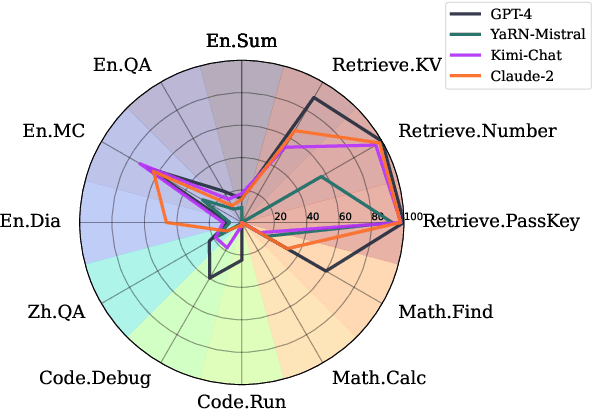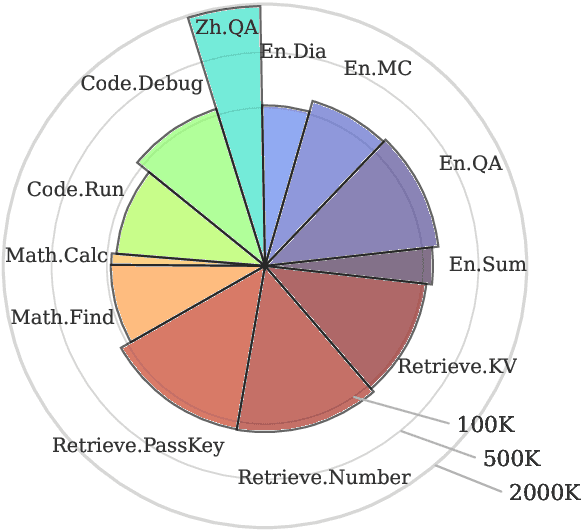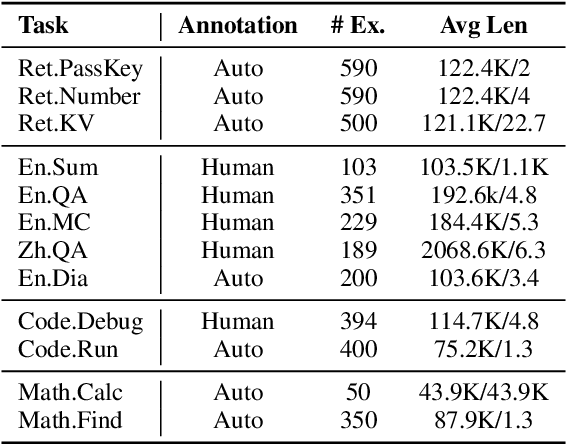Zhen Leng Thai
StateX: Enhancing RNN Recall via Post-training State Expansion
Sep 26, 2025Abstract:While Transformer-based models have demonstrated remarkable language modeling performance, their high complexities result in high costs when processing long contexts. In contrast, recurrent neural networks (RNNs) such as linear attention and state space models have gained popularity due to their constant per-token complexities. However, these recurrent models struggle with tasks that require accurate recall of contextual information from long contexts, because all contextual information is compressed into a constant-size recurrent state. Previous works have shown that recall ability is positively correlated with the recurrent state size, yet directly training RNNs with larger recurrent states results in high training costs. In this paper, we introduce StateX, a training pipeline for efficiently expanding the states of pre-trained RNNs through post-training. For two popular classes of RNNs, linear attention and state space models, we design post-training architectural modifications to scale up the state size with no or negligible increase in model parameters. Experiments on models up to 1.3B parameters demonstrate that StateX efficiently enhances the recall and in-context learning ability of RNNs without incurring high post-training costs or compromising other capabilities.
DecorateLM: Data Engineering through Corpus Rating, Tagging, and Editing with Language Models
Oct 08, 2024Abstract:The performance of Large Language Models (LLMs) is substantially influenced by the pretraining corpus, which consists of vast quantities of unsupervised data processed by the models. Despite its critical role in model performance, ensuring the quality of this data is challenging due to its sheer volume and the absence of sample-level quality annotations and enhancements. In this paper, we introduce DecorateLM, a data engineering method designed to refine the pretraining corpus through data rating, tagging and editing. Specifically, DecorateLM rates texts against quality criteria, tags texts with hierarchical labels, and edits texts into a more formalized format. Due to the massive size of the pretraining corpus, adopting an LLM for decorating the entire corpus is less efficient. Therefore, to balance performance with efficiency, we curate a meticulously annotated training corpus for DecorateLM using a large language model and distill data engineering expertise into a compact 1.2 billion parameter small language model (SLM). We then apply DecorateLM to enhance 100 billion tokens of the training corpus, selecting 45 billion tokens that exemplify high quality and diversity for the further training of another 1.2 billion parameter LLM. Our results demonstrate that employing such high-quality data can significantly boost model performance, showcasing a powerful approach to enhance the quality of the pretraining corpus.
$\infty$Bench: Extending Long Context Evaluation Beyond 100K Tokens
Feb 24, 2024



Abstract:Processing and reasoning over long contexts is crucial for many practical applications of Large Language Models (LLMs), such as document comprehension and agent construction. Despite recent strides in making LLMs process contexts with more than 100K tokens, there is currently a lack of a standardized benchmark to evaluate this long-context capability. Existing public benchmarks typically focus on contexts around 10K tokens, limiting the assessment and comparison of LLMs in processing longer contexts. In this paper, we propose $\infty$Bench, the first LLM benchmark featuring an average data length surpassing 100K tokens. $\infty$Bench comprises synthetic and realistic tasks spanning diverse domains, presented in both English and Chinese. The tasks in $\infty$Bench are designed to require well understanding of long dependencies in contexts, and make simply retrieving a limited number of passages from contexts not sufficient for these tasks. In our experiments, based on $\infty$Bench, we evaluate the state-of-the-art proprietary and open-source LLMs tailored for processing long contexts. The results indicate that existing long context LLMs still require significant advancements to effectively process 100K+ context. We further present three intriguing analyses regarding the behavior of LLMs processing long context.
OlympiadBench: A Challenging Benchmark for Promoting AGI with Olympiad-Level Bilingual Multimodal Scientific Problems
Feb 21, 2024



Abstract:Recent advancements have seen Large Language Models (LLMs) and Large Multimodal Models (LMMs) surpassing general human capabilities in various tasks, approaching the proficiency level of human experts across multiple domains. With traditional benchmarks becoming less challenging for these models, new rigorous challenges are essential to gauge their advanced abilities. In this work, we present OlympiadBench, an Olympiad-level bilingual multimodal scientific benchmark, featuring 8,952 problems from Olympiad-level mathematics and physics competitions, including the Chinese college entrance exam. Each problem is detailed with expert-level annotations for step-by-step reasoning. Evaluating top-tier models on OlympiadBench, we implement a comprehensive assessment methodology to accurately evaluate model responses. Notably, the best-performing model, GPT-4V, attains an average score of 17.23% on OlympiadBench, with a mere 11.28% in physics, highlighting the benchmark rigor and the intricacy of physical reasoning. Our analysis orienting GPT-4V points out prevalent issues with hallucinations, knowledge omissions, and logical fallacies. We hope that our challenging benchmark can serve as a valuable resource for helping future AGI research endeavors.
 Add to Chrome
Add to Chrome Add to Firefox
Add to Firefox Add to Edge
Add to Edge